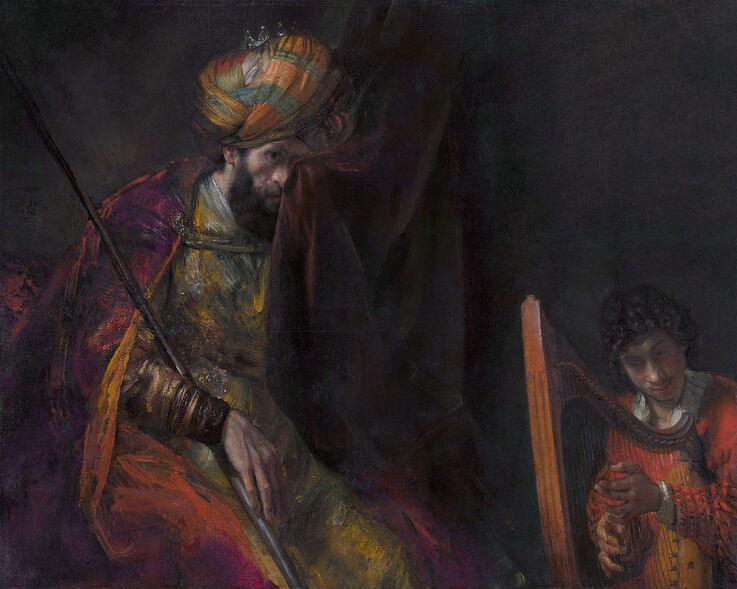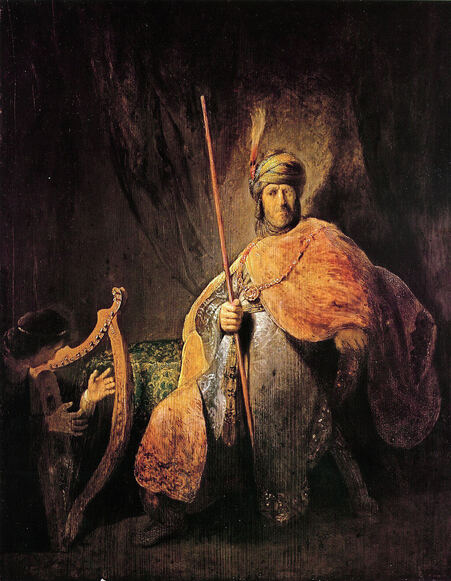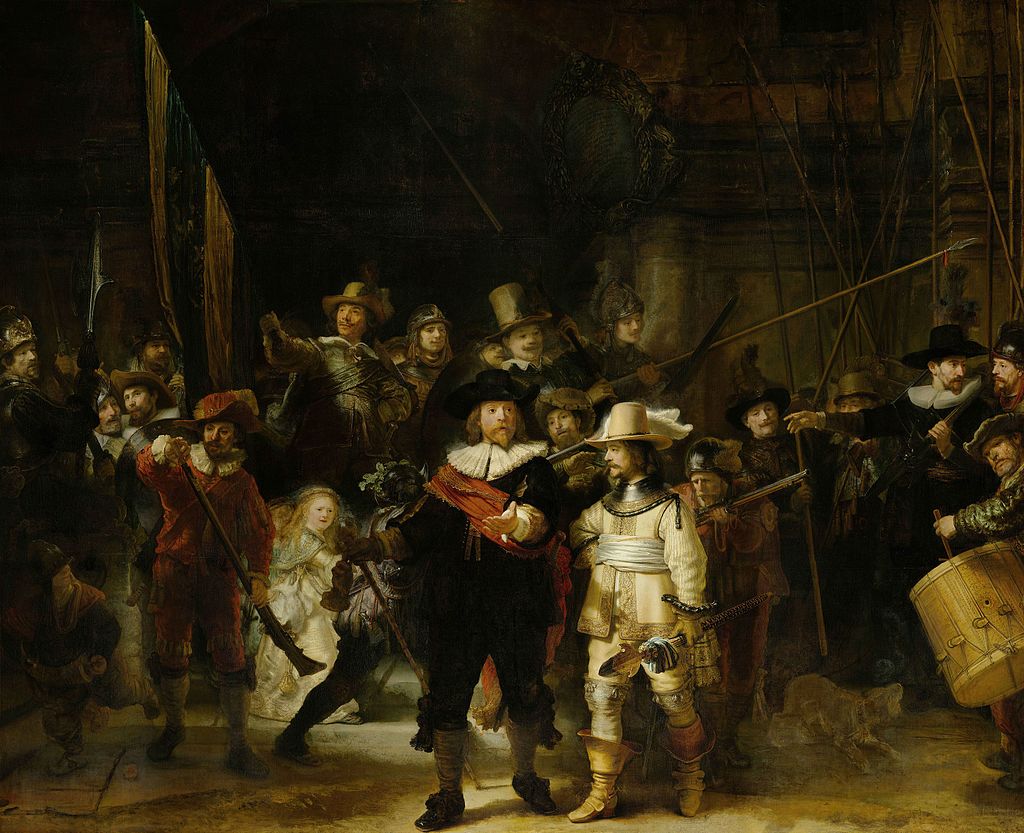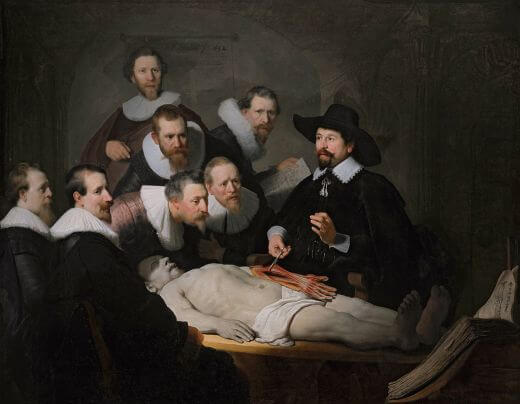|
Where? Room 10 of the Mauritshuis
When? Between 1651 and 1658 What do you see? King Saul is depicted on the left. He has a curtain in his left hand and a spear in his right hand. Saul suffered from melancholic moods. The young David is shown on the right. He is sitting a bit lower than Saul and plays the harp to calm down Saul when he experiences one of his depressive moods. David is absorbed in playing the harp and does not seem to notice Saul. However, Saul cannot contain his tears and is drying the tears in his left eye with the curtain. With his right eye, however, he is looking intensely at David, thinking about ways to kill him. Rembrandt offers us a view into the future of this story as not much later Saul will indeed throw his spear at David. Backstory: David has just beaten Goliath and the Philistines and is back in the palace of King Saul, who is afraid that David will take his position as king due to his enormous popularity. The story in the painting is based on 1 Samuel 18:10: “The next day an evil spirit from God suddenly took control of Saul, and he raved in his house like a madman. David was playing the harp, as he did every day, and Saul was holding a spear.” Saul was considering to kill David, but he also knew that if he did that the people would turn against him. Saul threw the spear twice at David, but David could dodge it both times. His next move was to send David to war in the hope that he would be killed there, but David was very successful in the war as God protected him. Symbolism: The painting reflects how Rembrandt imagined the scene in which David was playing the harp for the depressive King Saul. Most elements in the painting come directly from the 17th-century translation of the Bible, but most notably Rembrandt added the curtain. It allowed him to express two different emotions of Saul at once. The tears in his left eye because of the beautiful music and the anger and jealousy of David’s growing popularity in his other eye. More generally, Rembrandt expresses in this painting how music can help to diminish depressive moods. Rembrandt painted an earlier version on this same topic in which he did not express these emotions that clearly.
Why David and Saul? David has been a popular topic in art. One reason for his popularity is that his life and his experiences are described in great detail in the Bible, providing plenty of inspiration for artists. Another reason for his popularity in art is the range of emotions and roles that he fulfilled. He started as a young boy who was chosen by God to be the future King of Israel. Next, he became a hero by killing Goliath. Right after that, he was described as the great harp player who could calm down King Saul. Later he becomes king and even gets involved in an adulterous affair and murder.
Who is Rembrandt? Rembrandt Harmenszoon van Rijn (1606-1669) is one of the great painters of this world. He was born in Leiden, The Netherlands, but spend most of his adult life in Amsterdam. Rembrandt was a master of using the contrast between light and dark in his work. Rembrandt was a very productive artist, and much of his work involves religious scenes, self-portraits, and portraits of others. He has created almost 100 self-portraits in his life. Together with Caravaggio, Rembrandt is by many considered to be the greatest painter of the Baroque period. Some of his famous works include The Night Watch in the Rijksmuseum in Amsterdam and The Anatomy Lesson of Dr. Nicolaes Tulp which is also in the Mauritshuis.
A real Rembrandt? For a long time, this painting was considered a real Rembrandt painting. However, in 1969, doubt was cast on whether Rembrandt had painted this work. Art historian Horst Gerson published a book about all the paintings of Rembrandt and did not believe that Saul and David was painted by Rembrandt, but rather by one of his pupils. The interest in this painting suffered a lot because of this doubt.
Proving that this was a real Rembrandt or not turned out to be a rather difficult task. Only in 2007, the Mauritshuis started an 8-year long investigation, which eventually proved that the painting was, in fact, a real Rembrandt. The proof was difficult because the painting has been created in two different phases. In the first phase, a very precise painting technique was used (for example, look at David and the harp). In the second phase, the brushstrokes were less precise (for example, look at the cloak that Saul is wearing). Fun fact: This painting has been a mess over time. It has been cut into pieces and other people have painted on top of the original painting. If you look at the painting, you can see that it consist of three different pieces (this is much clearer in this picture of the painting before the restoration started). A big piece with Saul on the left, a smaller piece depicting David on the bottom right, and another smaller piece in the right top corner with just a dark background. The most probable reason for why this painting has been cut into different pieces is that the top right of the painting got damaged and that the owner has decided to create two rectangular painting out of it (one piece with Saul and another piece with David). However, this remains speculation. Interested in a copy for yourself? Poster or canvas
Written by Eelco Kappe
References:
1 Comment
Ron
5/31/2017 09:35:21 am
Thank you !
Reply
Leave a Reply. |
Categories
All
|
- Home
- Blog
-
Museums
- Alte Pinakothek
- Art Institute of Chicago
- Baltimore Museum of Art
- Barber Institute of Fine Arts
- Bargello
- Barnes Foundation
- British Museum
- Church of Sant’Anastasia
- Cleveland Museum of Art
- Courtauld Institute of Art
- Detroit Institute of Arts
- Frans Hals Museum
- Galleria Borghese
- Gallerie dell'Accademia
- Getty Museum
- Guggenheim
- Hermitage Museum
- Kunsthistorisches Museum
- Kunstmuseum Basel
- Legion of Honor Museum
- Louvre
- Mauritshuis
- Metropolitan Museum of Art
- Musee d’Orsay
- Museum of Fine Arts in Boston
- Museum of Modern Art
- National Gallery in London
- National Gallery of Art
- National Museum in Poznań
- Norton Simon Museum
- Ny Carlsberg Glyptotek
- Palace of Versailles
- Palazzo Pitti
- Palazzo Vecchio
- Petit Palais
- Philadelphia Museum of Art
- Prado
- Pushkin Museum
- Ravenna Art Museum
- Rijksmuseum
- San Diego Museum of Art
- Santa Maria delle Grazie
- St. Peter's Basilica
- Städel Museum
- Statens Museum for Kunst
- Tate Britain
- Tate Modern
- Timken Museum of Art
- Uffizi
- Vatican Museums
- Wallace Collection
-
Artists
- Altdorfer
- Anguissola
- Berlin Painter
- Bosch
- Botticelli
- Boucher
- Bronzino
- Bruegel the Elder
- Brunelleschi
- Cabanel
- Caillebotte
- Canova
- Caravaggio
- Carpeaux
- Cezanne
- Cimabue
- David
- Degas
- Delacroix
- De Maria
- Donatello
- El Greco
- Fontana
- Fra Angelico
- Fragonard
- Gauguin
- Gentileschi
- Gericault
- Gonzalez-Torres
- Goya
- Hals
- Hogarth
- Hokusai
- Ingres
- Leonardo da Vinci
- Lippi, Filippo
- Longhi, Barbara
- Lorrain
- Makovsky
- Manet
- Massys
- Matisse
- Merian
- Michelangelo
- Mochi
- Modigliani
- Monet
- Panini
- Parmigianino
- Perugino
- Picasso
- Pisanello
- Raphael
- Rembrandt
- Renoir
- Reynolds
- Rivera
- Rodin
- Rubens
- Scultori
- Seurat
- Steen
- Tintoretto
- Titian
- Toulouse-Lautrec
- Turner
- Uccello
- Van der Weyden
- Van Dyck
- Van Eyck
- Van Gogh
- Van Hemessen
- Vasari
- Velazquez
- Vermeer
- Veronese
- Vigée Le Brun
-
Locations
- Books
- About Us




